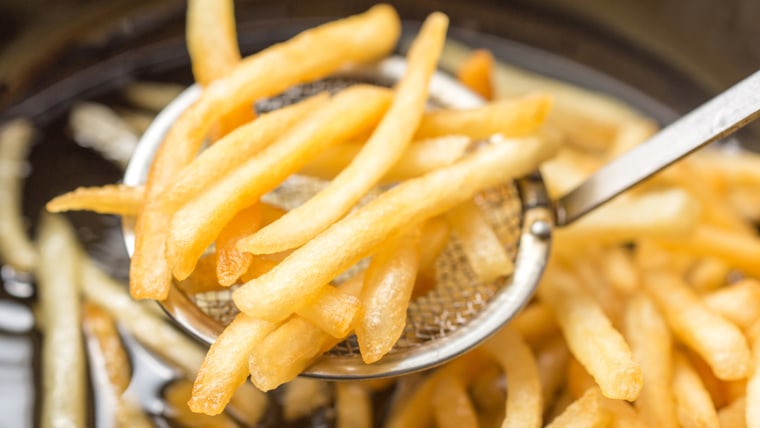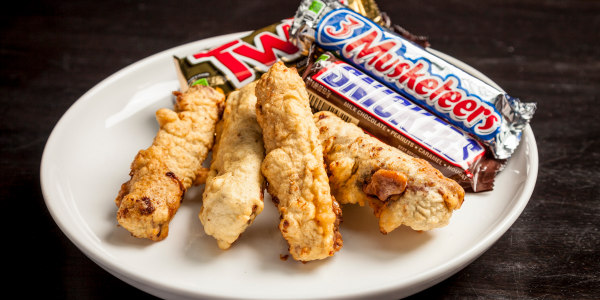
From fried chicken to doughnuts, the irresistible combination of a crispy exterior and moist interior is all thanks to a deep fryer. But often times, home cooks are apprehensive about cooking with lots of oil for health and safety reasons. Here, 10 tips from frying expert Chris Sell, chef and owner of ChipShop in Brooklyn, New York, to help you master your deep frying technique and get comfortable with one of the tastiest cooking methods out there.
1. Choose your oil wisely
You might be tempted to use extra-virgin olive oil, but with its low smoke point and distinctive flavor, it's not your best option. Instead, Sell advises using vegetable oil because it has a high smoke point, a neutral flavor and is super economical. "A neutral-flavored oil allows the food to shine," says Sell. Peanut and grape seed oils are two other options that have neutral flavors and high smoke points. Also, if you're reusing oil, be sure to filter it first so it doesn't give your food a dirty flavor. "If your food tastes burnt but doesn't look it, it's because of dirty oil," says Sell.
2. Get the right equipment
An ideal home deep fryer allows the oil to maintain a consistent temperature, has a basket or handheld strainer with a non-metal handle and a feature that filters and preserves the remaining oil for future use. A dedicated deep fryer is much, much safer than using a big pot, according to Sell, and you can find a good one for under $50.
If you don't have a deep fryer and are an experienced home cook, you can use a large and deep heavy-bottomed pot like a cast iron Dutch oven. The heft helps retain high temperatures and prevent the heat from fluctuating too much, enabling the oil to cook your food more evenly—and more quickly. The high sides also prevent oil from splattering, but remember to never fill a pot more than halfway with oil or you could have a grease fire on your hands. You'll also need a digital thermometer and under no circumstances can you leave the pot unattended. Got it? Good. Again, getting a dedicated deep fryer is a much better and safer way to go.
3. Season your flour
Whether you're planning to deep fry fish or a Twinkie, dredging your food in flour is a key first step. "The flour makes the batter stick to the food," Sell says. "If you don't use flour first, your batter could just slip off." For savory fried foods, you can simply add salt and pepper to the flour, but feel free to experiment with other spices like garam masala for an Indian-style take. As for sweet fried foods, you can add sugar or cocoa powder to the flour, but don't forget the salt. "Salt makes everything more delicious, even something like a candy bar," Sell says. After getting coated in the seasoned flour, it's time to get battered up.
4. Make the Perfect Batter
Fried foods should have a wonderfully crisp outer layer and the best way to get one is with the right batter. "You want the batter to be very fresh and very thin,' says Sell. His favorite batter is just five ingredients (flour, baking soda, malt vinegar, salt and water), but there are a few things to keep in mind:
- For the best possible result, start by making sure that your ingredients are absolutely fresh. That means no rancid flour (pitch it if it smells bad) and don't even think about using the baking powder that's been sitting in your fridge absorbing odors. The baking powder is the key ingredient to making the batter light and airy—it gives the batter a lift according to Sell.
- Water is Sell's preferred batter liquid instead of beer or soda water because he finds that the carbonation goes flat quickly and doesn't make much of a difference. The only exception is if you're making a tempura. In that case, Sell recommends using soda water, but work quickly—the batter should be made only two minutes before you start frying to take advantage of the carbonation.
- Flavor your batter with your favorite spices and sauces. "It's better to season the batter than to season the food afterwards," says Sell. Sell's go-to savory combination is granulated garlic, chile powder, sage, celery salt, salt and pepper. Try mixing in cayenne pepper or hot sauce if you like spicy food or throw in some curry powder if you're frying up cauliflower, for example. For a dessert, try adding cocoa powder or chocolate syrup to the batter. Or mix up a cake batter for an over-the-top deep-fired peanut butter and jelly sandwich. Don't forget that you can also fry cake batter to make fried dough. Feel free to experiment and you might come up with something awesome!
- Skip the fork and use a whisk to combine your ingredients or "beat the heck out of them" as Sell says. The whisk will help you incorporate as much air as possible which will make the batter light and airy. "A thinner batter results in a crispier crust and you want your batter to be about the same consistency as a crème anglaise," says Sell.
- For slippery foods, like sausages, dredge and batter them, then let the batter set a bit before putting them in the oil. This way the batter won't slip off.
- Don't keep the mixed batter for more than four hours because it will get doughy. Throw away the remaining batter after you've finished frying and always start with fresh batter the next time.
5. Put safety first
If you're using a dedicated deep fryer, the temperature should be clearly displayed at all times. If you're using a pot to deep fry, use your digital thermometer to keep an eye on the temperature of the oil. You want it to be somewhere between 375°F and 400°F. Also key: never (EVER!) leave the oil unattended and if you see the oil starting to smoke, the temperature's getting too high and you need to turn off the heat immediately to avoid a grease fire. Also, remember you should NEVER throw water on a grease fire. Before you start deep frying out of a pot, there are a few items that you should have handy, preferably on the countertop where you are working. First of all, have the lid on hand so you can cover the top immediately. Also, keep a box of baking soda close by and if needed, pour on the powder with a heavy hand. Sell also recommends using damp—not wet—tea towels to help smother any flames. And of course, call 911 in case of an emergency.
6. Don't crowd the deep fryer
Overcrowding your deep-fryer or pot will lower the oil's temperature, which can result in food that's not properly deep-fried. "Think of it as a bath; you don't want too many people in there," says Sell. You need the food to be able to move around and flip over. Slowly lower in the food to prevent splattering.
7. Experiment with your fried chicken
Sell may be one of the country's biggest deep fryer enthusiasts, but the one fried food he thinks is better when it's fried in a pot or pan is fried chicken. New Orleans chef and restaurateur John Besh agrees and told TODAY about his grandmother Grace's special method for making amazingly juicy fried chicken with a perfect crust: "After the chicken was in the hot oil, my grandmother would put the lid on her pot and a kind of pressure cooker thing began to happen inside—the meat inside gets to cook, leaving the outside crispy." Recipe to try: Grandmother Grace's Fried Chicken
8. Prevent oily food
If your food is really oily, the biggest culprit is a too low cooking temperature. High temperatures ensure that the batter reacts and creates a barrier between the oil and the food. If your oil's temperature it too low, the food will soak up the oil and will not result in a steamed interior. Once your food has been cooked, remove it from the oil. At his restaurant, Sell uses a basket to strain the food and most deep fryers will come with this feature. "Shake off the oil and you're good to go." If you're not using a straining basket, create your own set-up: Line a baking sheet with a paper towel to catch oil, and place a cooling rack on top. The rack will allow the food to cool down.
9. Healthy frying does exist
Besides moderation, there's another way to think about the possibility of "healthy" deep-frying. Go with me on this. Let's say you're working with a fresh fillet of fish or some big juicy shrimp—foods that are presumably healthy on their own. When they're dredged in flour, placed in batter and deep fried in very hot oil (this is key), the batter crisps immediately and the seafood is cooked by the steam of its own juices inside the batter. In fact, the seafood is actually less likely to get dried out than if you used a steaming basket over boiling water. After deep-frying, if you peel away and discard the fried batter, "you'll have a more flavorful steamed product," says Sell.
10. Reuse and clean up
Some deep fryers can filter the cooking oil so that you can actually reuse it. You can also strain the oil, once it's cooled, through a cheesecloth. Store the oil in a dark, cool place. When it's time to dispose of the oil, don't put it down your sink (or toilet, for that matter). Instead, let it cool before discarding it in a sealable container, or soak it up with paper towels. According to the New York City's Department of Environmental Protection, cooking oil and grease should be disposed of with your trash.
